Home » Interplanetary space physics (including cosmic ray physics)
Category Archives: Interplanetary space physics (including cosmic ray physics)
Current state and perspectives of Space Weather science in Italy
Papers from SWICo members
Plainaki Christina, Antonucci Marco, Bemporad Alessandro, Berrilli Francesco, Bertucci Bruna, Castronuovo Marco, De Michelis Paola, Giardino Marco, Iuppa Roberto, Laurenza Monica, Marcucci Federica, Messerotti Mauro, Narici Livio, Negri Barbara, Nozzoli Francesco, Orsini Stefano, Romano Vincenzo, Cavallini Enrico, Polenta Gianluca, Ippolito Alessandro
This paper presents a brief state-of-the-art in Space Weather science in Italy and discuss some ideas on a long-term plan for the support of future scientific research in the related disciplines. Italian teams contributed in the advancing of our knowledge on the properties and evolution of the Space Weather phenomena with observational campaigns from space and from the ground. Numerous Space Weather forecasting and now-casting modeling efforts have resulted in a remarkable add-on to the overall progress in the field, at both national and international level. The Italian Space Agency participated several times in space missions related to Space Weather; indeed, the development of new instrumentation for future Heliophysics and Space Weather space missions will be very important for the Italian scientific and industrial communities.
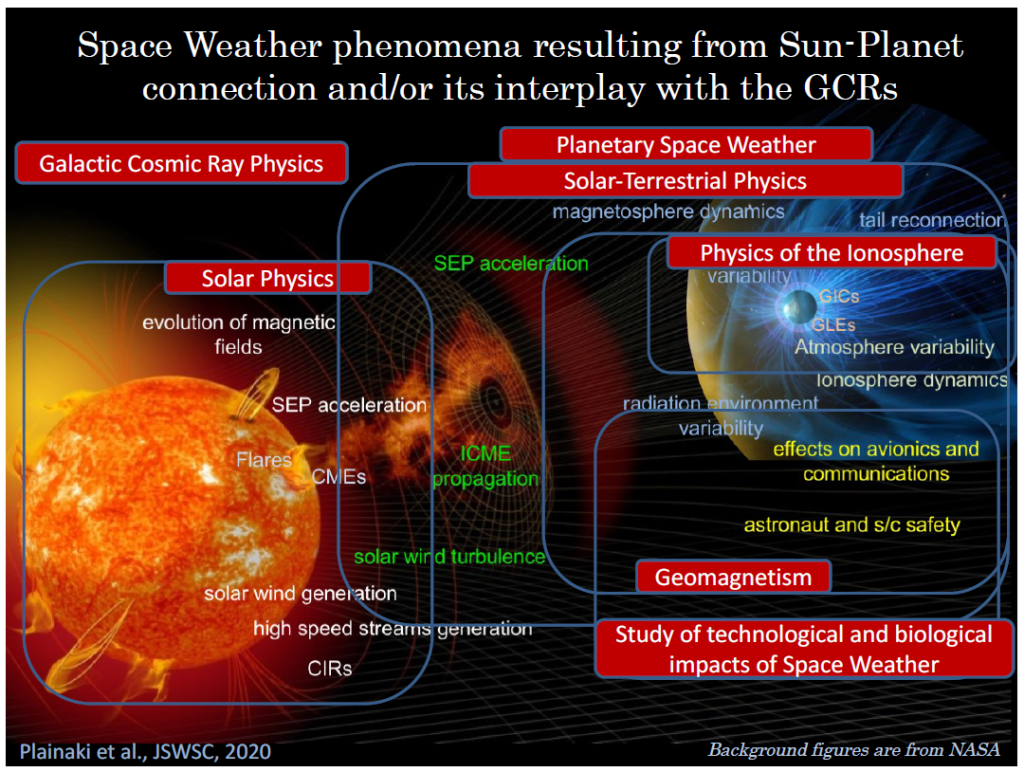
The Italian Space Agency aims to assess the possibility to develop a national scientific Space Weather data centre to encourage synergies between different science teams with interest in the field and to motivate innovation and new mission concept development. Alongside with the proposed recommendations, this paper also discusses how the Italian expertise could complement international efforts in a wider international Space Weather context.
Publication: Plainaki C., Antonucci M., Bemporad A., Berrilli F., Bertucci B., Castronuovo M., De Michelis P., et al., 2020, JSWSC, 10, 6. doi:10.1051/swsc/2020003. https://www.swsc-journal.org/articles/swsc/abs/2020/01/swsc190014/swsc190014.html
On the identification of coherent structures in space plasmas: the magnetic helicity-PVI method
Papers from SWICo members
F. Pecora, S. Servidio, A. Greco, W. H. Matthaeus
Plasma turbulence can be viewed as a magnetic landscape populated by large- and small-scale coherent structures. In this complex network, large helical magnetic tubes might be separated by small-scale magnetic reconnection events (current sheets). However, the identification of these magnetic structures in a continuous stream of data has always been a challenging task.
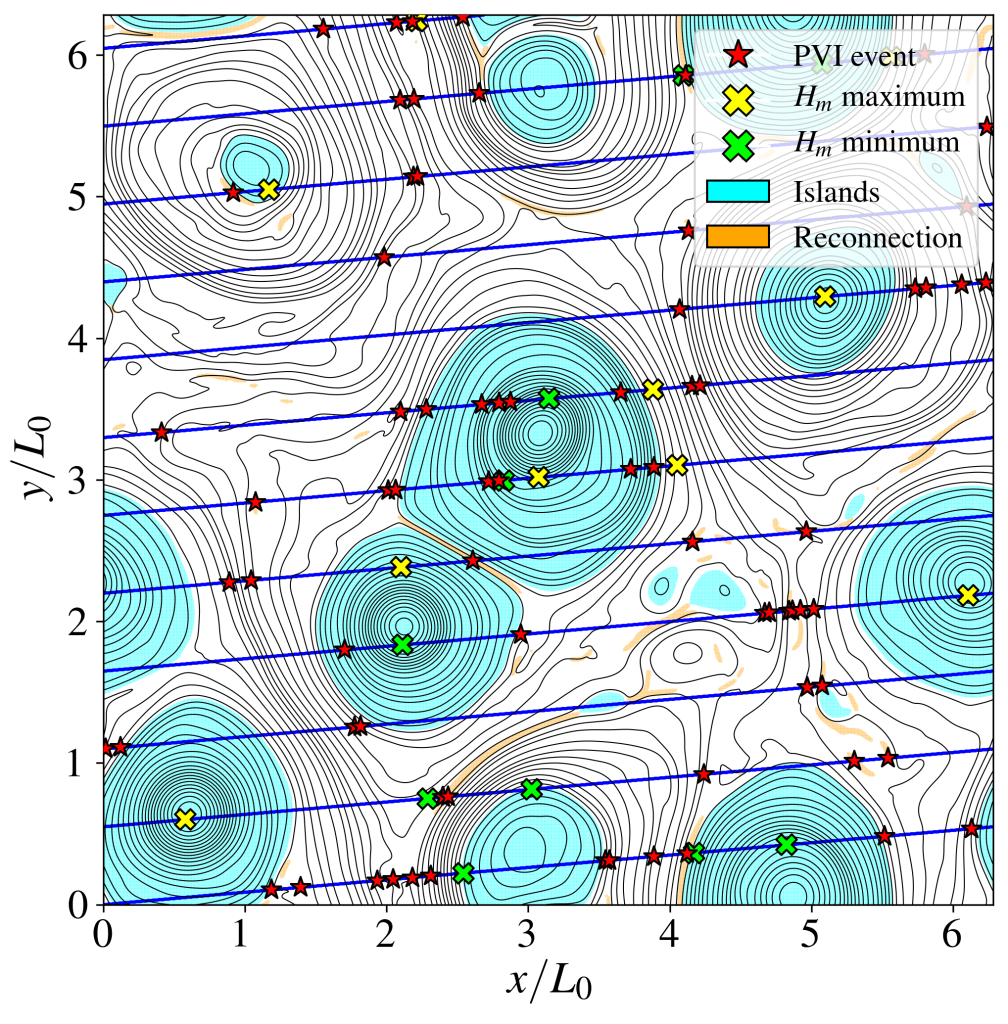
Here we present a method that is able to characterize both the large and small scale structures of the turbulent solar wind, based on the combined use of a filtered magnetic helicity (H_m) and the Partial Variance of Increments (PVI).
This simple, single-spacecraft technique, has been validated first via direct numerical simulations of plasma turbulence and then applied to data from the Parker Solar Probe (PSP) mission.
This novel analysis, combining H_m~PVI methods, reveals that a large number of flux tubes populate the solar wind and continuously merge in contact regions where magnetic reconnection and particle acceleration may occur.
Publication: Pecora F., Servidio S., Greco A., Matthaeus W.~H., 2021, A\&A, 650, A20. doi:10.1051/0004-6361/202039639. https://www.aanda.org/component/article?access=doi&doi=10.1051/0004-6361/202039639
Detection Capability of Flux Ropes during the Solar Orbiter Mission
Papers from SWICo members
Telloni, Daniele; D’Amicis, Raffaella; Bruno, Roberto; Carbone, Francesco; Perrone, Denise; Zank, Gary P.; Zhao, Lingling; Nakanotani, Masaru; Adhikari, Laxman
Flux ropes are interplanetary magnetic helical structures that are receiving increasing attention because of their likely role in magnetohydrodynamic (MHD) processes as well as their impact on space weather science. A very promising and powerful approach to address their investigation and characterization is based on wavelet spectrograms of the invariants of the ideal MHD equations.
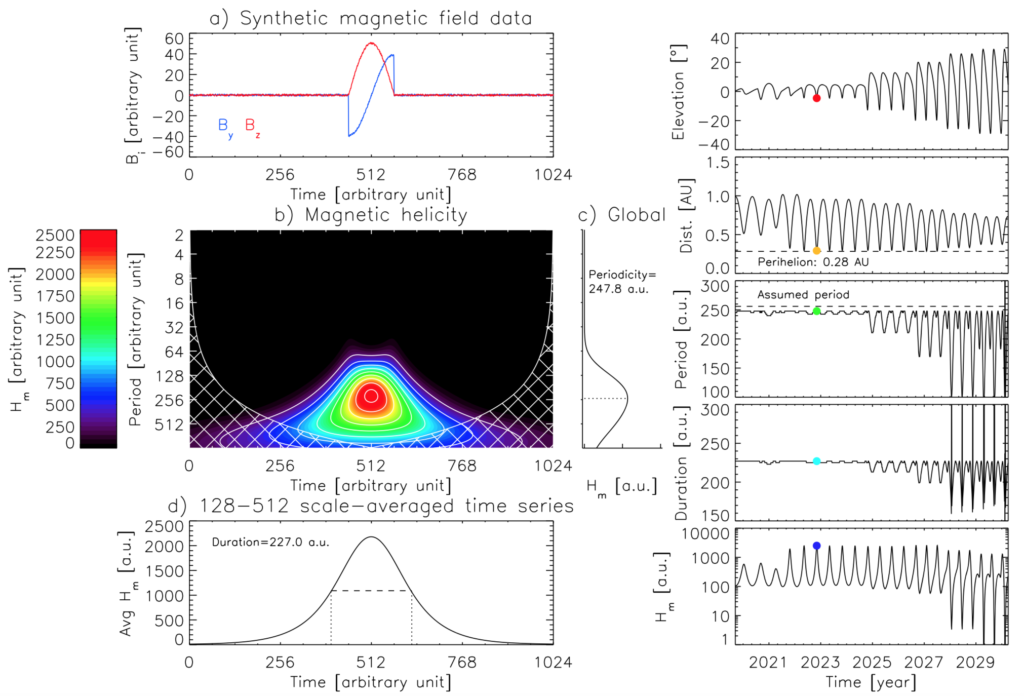
The accuracy of this method to infer flux rope properties depends on the proper evaluation of the direction of propagation of the flux rope itself, which is often difficult to assess. We present a numerical test of the reliability of this diagnostic technique, by simulating a synthetic flux rope of fixed size and propagation direction along the Solar Orbiter orbit, that is very elongated and inclined with respect to the orbital plane. We find that when the flux rope is crossed for less than 50% of its width, the procedure becomes unreliable. Quantitative information on how to properly recover the flux-rope intrinsic properties is provided.
Publication: Telloni D., D’Amicis R., Bruno R., Carbone F., Perrone D., Zank G. P., Zhao L., et al., 2020, ApJL, 899, L25.
https://iopscience.iop.org/article/10.3847/2041-8213/abacc4
Study of the Influence of the Solar Wind Energy on the Geomagnetic Activity for Space Weather Science
Papers from SWICo members
Telloni, Daniele; Carbone, Francesco; Antonucci, Ester; Bruno, Roberto; Grimani, Catia; Villante, Umberto; Giordano, Silvio; Mancuso, Salvatore; Zangrilli, Luca
This paper addresses the investigation of the interaction of the solar wind energy with the Earth’s magnetosphere, by studying its correlation with the disturbance storm time (Dst) index, a proxy of the geomagnetic activity. Some relevant parameters of the solar wind (the bulk speed and the z-component of the interplanetary magnetic field) are explored in the energy-Dst space.
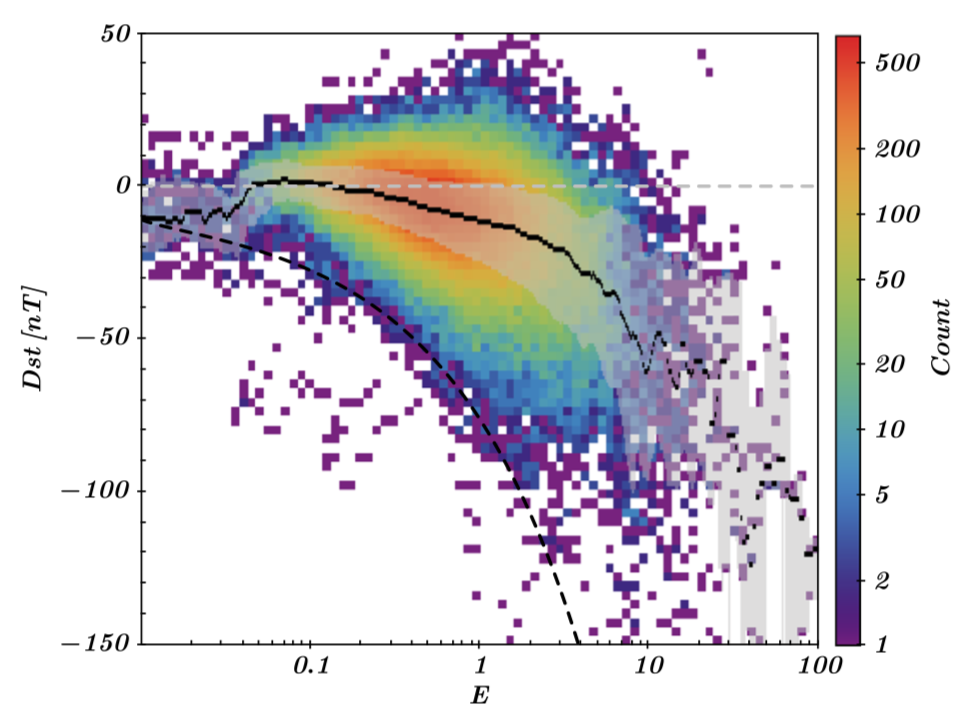
It results that (I) the solar wind energy and the geomagnetic activity are strictly related, with the coronal mass ejections representing the most energetic and geoeffective driver; (II) the slow solar wind has negligible effects on Earth regardless of its energy content, whereas high-speed streams may induce severe geomagnetic storming depending on the advected energy; and (III) while at low and mid energies, geomagnetic disturbances are induced provided the magnetic reconnection between the interplanetary and terrestrial magnetic fields occurs, high-energy solar wind plasma can impact Earth even without reconnecting with the geomagnetic field at the dayside magnetopause. The most significant result in the framework of space weather science resides in the observational evidence that the Earth’s magnetosphere has a maximum response to the energetic content of the solar wind, which leads to the derivation of an empirical law allowing the proper forecast of the upper limit of the intensity of any geomagnetic disturbance on the basis of the solar wind energy derived in situ at the Lagrangian point L1.
Publication: Telloni D., Carbone F., Antonucci E., Bruno R., Grimani C., Villante U., Giordano S., et al., 2020, ApJ, 896, 149.
https://iopscience.iop.org/article/10.3847/1538-4357/ab91b9/pdf
Detection of Coronal Mass Ejections at L1 and Forecast of Their Geoeffectiveness
Papers from SWICo members
Daniele Telloni , Ester Antonucci, Alessandro Bemporad, Tiziano Bianchi, Roberto Bruno, Silvano Fineschi, Enrico Magli, Gianalfredo Nicolini, and Roberto Susino
A novel tool aimed to detect solar coronal mass ejections (CMEs) at the Lagrangian point L1 and to forecast their geoeffectiveness is presented in this paper. This approach is based on the analysis of in situ magnetic field and plasma measurements to compute some important magnetohydrodynamic quantities of the solar wind (the total pressure, the magnetic helicity, and the magnetic and kinetic energy), which are used to identify the CME events, that is their arrival and transit times, and to assess their likelihood for impacting the Earths magnetosphere.
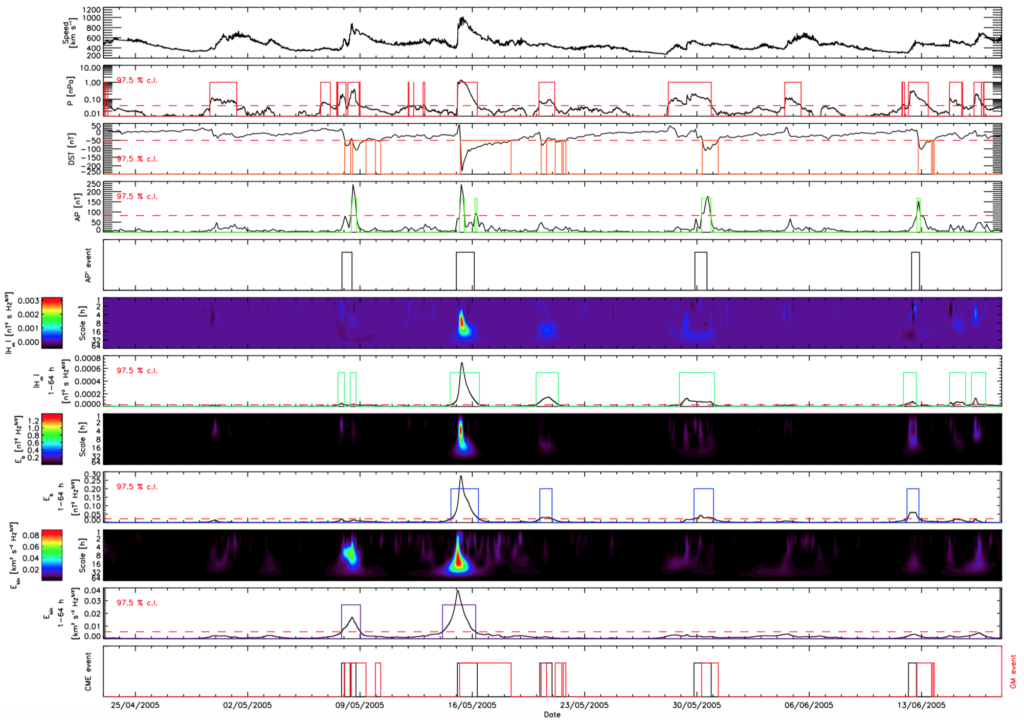
The method is essentially based on the comparison of the topological properties of the CME magnetic field configuration and of the CME energetic budget with those of the quasi-steady ambient solar wind. The algorithm performances are estimated by testing the tool on solar wind data collected in situ by the Wind spacecraft from 2005 to 2016. In the scanned 12 yr time interval, it results that (i) the procedure efficiency is of 86% for the weakest magnetospheric disturbances, increasing with the level of the geomagnetic storming, up to 100% for the most intense geomagnetic events, (ii) zero false positive predictions are produced by the algorithm, and (iii) the mean delay between the potentially geoeffective CME detection and the geomagnetic storm onset if of 4 hr, with a 98% 2-8 hr confidence interval. Hence, this new technique appears to be very promising in forecasting space weather phenomena associated to CMEs.
Publication: Telloni D., Antonucci E., Bemporad A., Bianchi T., Bruno R., Fineschi S., Magli E., et al., 2019, ApJ, 885, 120. doi:10.3847/1538-4357/ab48e9
https://iopscience.iop.org/article/10.3847/1538-4357/ab48e9/pdf
Single-spacecraft Identification of Flux Tubes and Current Sheets in the Solar Wind
Papers from SWICo members
Authors:
F. Pecora, A. Greco, Q. Hu, S. Servidio, A. Chasapis, W. H. Matthaeus
In this work we present a novel technique, based on two consolidated models, for describing and visualising the local topology of the magnetic field solar wind using single-spacecraft data. The Grad-Shafranov (GS) reconstruction method provides a two-dimensional map of the magnetic field surrounding the spacecraft trajectory, while the Partial Variance of Increments (PVI) technique is able to identify coherent magnetic structures, such as current sheets. We applied this combined technique to one month of magnetic field data measured by Wind satellite at 1 AU. In this stream we selected the flux rope events, that are structures with cylindrical symmetry and a relatively strong magnetic field along the symmetry axis. These flux tubes are quite large structures (a fraction of AU) and have a complex inner structure and they interact each other while moving in the Solar Wind.
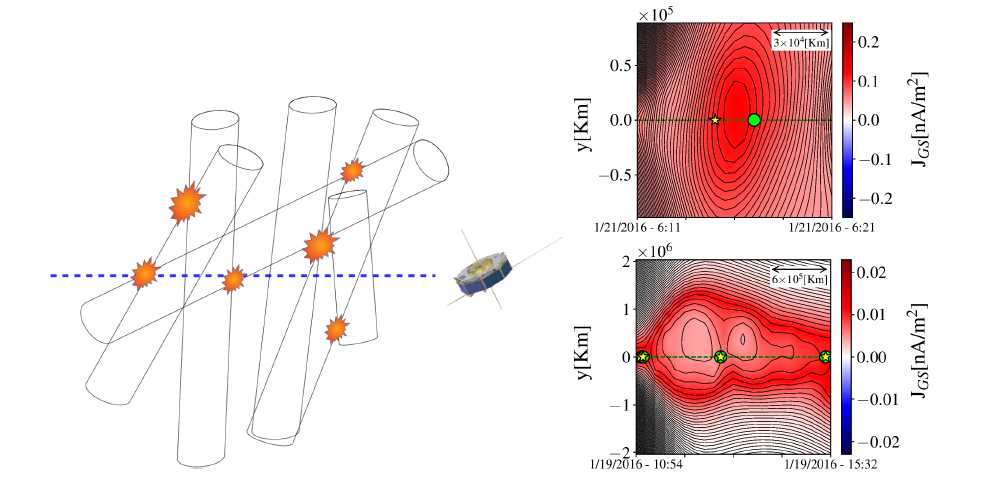
These inner and outer interactions can possibly generate sites of magnetic reconnection where strong current sheets appear. What we observed from the reconstruction is that a quasi-two-dimensional turbulence emerges as a sea of nested magnetic islands with current sheets located mostly at their boundaries. The method shows great promise for visualising and analysing single-spacecraft data from missions such as Parker Solar Probe and Solar Orbiter, as well as 1 AU SpaceWeather monitors such as ACE, Wind, and IMAP.
Publication: Pecora F., Greco A., Hu Q., Servidio S., Chasapis A. G., Matthaeus W. H., 2019, ApJL, 881, L11. doi:10.3847/2041-8213/ab32d9
https://iopscience.iop.org/article/10.3847/2041-8213/ab32d9
Forecasting the 2018 February 12th CME propagation with the P-DBM model: a fast warning procedure
Papers from SWICo members
Authors:
Dario Del Moro, Gianluca Napoletano, Roberta Forte, Luca Giovannelli, Ermanno Pietropaolo, Francesco Berrilli
The forecast of the time of arrival of a Coronal Mass Ejection (CME) to Earth is of critical importance for our high−technology society and for the Earth’s upper atmosphere status and LEO satellites. We realized a procedure based on the Drag−Based Model which uses probability distributions, rather than exact values, as input parameters, and allows the evaluation of the uncertainty on the forecast. The P−DBM belongs to a family of models that apply a somewhat simplified description of the main interaction the ICME is subject to during its interplanetary journey. The drag−based models (DBMs) assume that beyond a certain heliospheric distance, a simple aerodynamic drag equation can describe the interaction between the ICME and the solar
wind environment.

Ensemble modeling incorporate the intrinsic limitation of information due to measure errors or due to the lack of measure at all, in form of probability distributions. In practice, instead of a single run to forecast an ICME propagation, a set of runs, driven with input parameters extracted from suitable distributions are used to retrieve a distribution of output parameters. We tested this approach using a set of CMEs whose transit times are known, obtaining extremely promising results.
We realized a real−time implementation of this algorithm which ingests the outputs of automated CME tracking algorithms as inputs to provide early warning for those CME approaching Earth. We present the results of this real−time fast warning procedure for the case of the 2018 February 12th
CME.
Publication: DEL MORO, Dario et al. Forecasting the 2018 February 12th CME propagation with the P-DBM model: a fast warning procedure. Annals of Geophysics, [S.l.], v. 62, n. 4, p. GM456, dec. 2019. ISSN 2037-416X.
https://www.annalsofgeophysics.eu/index.php/annals/article/view/7750
